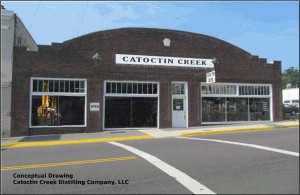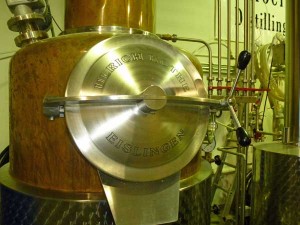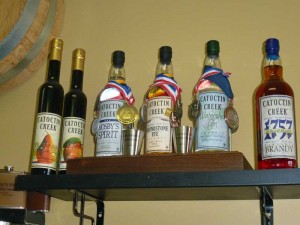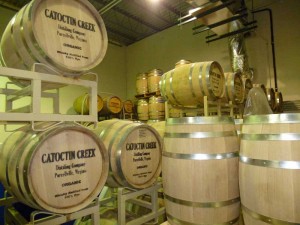By Jake Emen
At Catoctin Creek Distilling Company, it’s all about the rye. Founded in 2009, Catoctin Creek is based in Purcellville, Virginia, and is the first distillery to operate in Loudon County since before Prohibition. It’s about an hour outside of Washington D.C. — an easy drive down 267 West, past Dulles Airport.
I recently visited Catoctin Creek and spoke with co-owner and distiller Scott Harris about the distillery, their whiskeys and other spirits, and more.
Becoming a Washington, D.C. Institution
If you live in or around Washington D.C., then it’s likely you’ve been seeing more and more of Catoctin Creek these days. In 2012, they increased their production to 40,000 bottles, double 2011’s level, and they have formed a variety of local partnerships. So it is that you’ll find the private label 515 exclusively at J&G Steakhouse at the W Hotel in D.C.; or if you went to D.C. Brau brewery, you’d see a rack of Catoctin Creek barrels put to use; or if you went to the 2012 Farmland Feast, you’d have seen their whiskey up for grabs in a charity-auction… and on down the line from there. From top to bottom, Catoctin Creek is a very locally-focused, community-driven operation. Enthusiastic volunteers actually do all of their bottling by hand during their filled-to-capacity weekend bottling workshops.
By this summer, Catoctin Creek plans to be setup in a much larger and more aesthetically-pleasing facility on Main Street in Purcellville, as opposed to their current modest, industrial-park setting. There, they will have a new 300-gallon Kothe still (they currently utilize a 100-gallon Kothe still, which they’ll be keeping as well) with triple the floor space and a welcoming setting for a large tasting room.
Rye, Rye, and More Rye
Catoctin Creek produces a family of four whiskeys, all from 100% organic rye. As previously mentioned, they’re all about the rye. “We just want to do rye and do it really, really well,” says Harris. They even make a gin from the same rye base, but more on that later.
Less than five years in, and the results are more than promising. Their signature Roundstone Rye, which equals half of their total production, is a recipient of a 2013 gold seal at the Good Food Awards. It has also won a Gold in 2012 from The Fifty Best and has been highly rated by a number of publications, including receiving an 80 from Whisky Advocate.
“What we’re trying to produce here is a whiskey which was reminiscent of some whiskeys you’d find around Prohibition,” says Harris.
It’s spicy, well-balanced and easy-sipping, and certainly deserves a starring role in your go-to trifecta of vintage rye whiskey cocktails, whether it’s the Manhattan, Sazerac or Old Fashioned. Roundstone Rye is aged for just-under two years in small, 30-gallon new Minnesota white oak barrels. All of their spirits are single barrel products, which provides its trademark variation to the distilling process from bottle to bottle, and barrel to barrel.
“In our case, every barrel is a single barrel whiskey. So what we do to get the conformity we want is vary the time [of aging],” says Harris. “So if we get a particularly hot summer or a particularly cold winter, maybe a few months more, a few months less.”
Unless, that is, they decide not to age the whiskey, in which case they produce Mosby’s Spirit. A white whiskey named for the Confederate raider, it is surprisingly drinkable, with a light citrus and floral aroma, and a grainy flavor profile. Personally, I haven’t been a fan of many white whiskeys, but was impressed by Mosby’s. The key, according to Harris, begins with the correct intentions, and the quality starting base which their rye provides.
“I think [other distillers] make a mistake of putting something into a bottle which should be going into a barrel,” says Harris. “When we started producing the Mosby’s, we aimed to produce a white whiskey that was truly drinkable on its own as a white spirit. It’s meant to be drank white.”
Catoctin also produces two other takes on Roundstone Rye. The first is their Cask Proof offering, which they only produce several hundred bottles of once or twice per year. With a 58% ABV, as opposed to 40%, this is a much deeper and bolder whiskey, but still retains a nice rye spice and complex flavoring without becoming just about the burn.
“This one is really enjoyed by the enthusiasts, people who really like a strong dram and want to add their own water to it and just enjoy it for what it is,” says Harris.
The second offering is the aforementioned 515 private label, which is actually a careful blend of Roundstone Ryes from the barrel, with Mosby’s Spirit. It’s exclusive to J&G Steakhouse, and by contract is not available for sale elsewhere, even at the distillery itself in Virginia.
“We worked with [J&G Steakhouse’s] sommelier to take different ages of the spirit from the barrel and cross blend them,” says Harris. “It was his idea, and if you bring some of the younger ages back into the aged whiskey, what you’re getting is a fresher, lighter flavor, plus the deeper, richer flavor. I’m amazed that people know about it so much, because it’s just this little thing with J&G, and people come asking to buy it here and we’re actually not allowed to sell it here. We can only sell it through J&G at the W Hotel. It’s an exclusive to them.”
Green Distilling
Besides being focused on rye, Catoctin Creek is unique for several other reasons. To begin with, they are certified as both organic and Kosher. You don’t see that at too many distilleries.
Oh, and did I mention they produce a gin by redistilling a byproduct of their whiskey? It’s a process which came about due to the distillery’s focus on quality while producing Roundstone Rye.
In whiskey distillation, there are three outputs: Heads, which are poisonous; Hearts, the good stuff; and Tails, which exhibit poor taste and lower alcohol levels. Instead of reincorporating their tails into the next batch of whiskey, a common practice, Catoctin redistills it and makes something new.
Here’s how Harris describes the creation of Catoctin’s Watershed Gin: “We were making very conservative cuts on the Roundstone Rye, to make it really clean and nice. The hearts are pure, which means we have a lot more tails than most of the other distillers… And we decided to redistill them and play with them. So we started playing with some gin recipes, and it really became an outgrowth, or byproduct, of the whiskey production. And now it’s our number 2 best seller.”
Watershed Gin isn’t a typical London Dry Gin, either. While it retains a fresh, piney taste from juniper, it has a complex flavor with the presence of coriander, and more telling, anise, which provides a licorice profile.
Besides using the tails from their whiskey distillation to produce gin, Catoctin Creek freely provides their spent mash to local farms, and they even use the poisonous heads from the distillation for cleaning products. Through all of these mechanisms, they are actually a no-waste distillery.
Availability
Catoctin Creek’s spirits are primarily available in the D.C. metro area of Maryland, Washington D.C. and Virginia, as well as New York. However, they’re now also available in Pennsylvania, Tennessee, Kentucky and Wyoming.
Catoctin Creek Distilling Company is located at 37251-C East Richardson Lane in Purcellville, VA. Learn more about them and their spirits at CatoctinCreekDistilling.com. Tours and tastings are offered from Monday-Saturday.
 The Whiskey Reviewer A World of Whiskey, Poured Every Weekday
The Whiskey Reviewer A World of Whiskey, Poured Every Weekday





One comment
Pingback: DC Restaurant Openings & Buzz: Beer & More Beer from Dupont to VA to Silver Spring | Man Talk Food